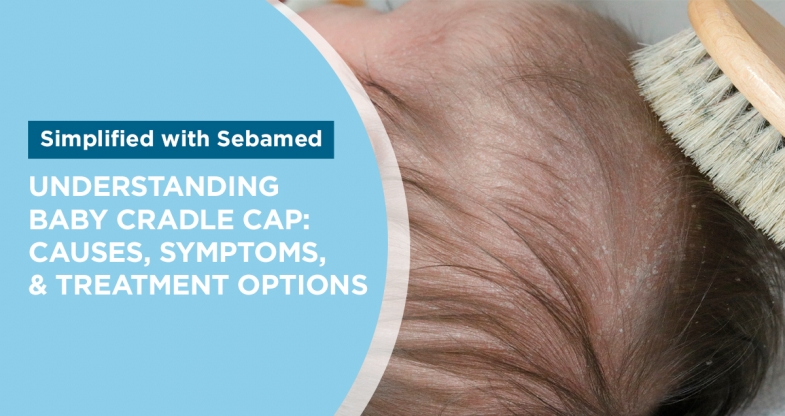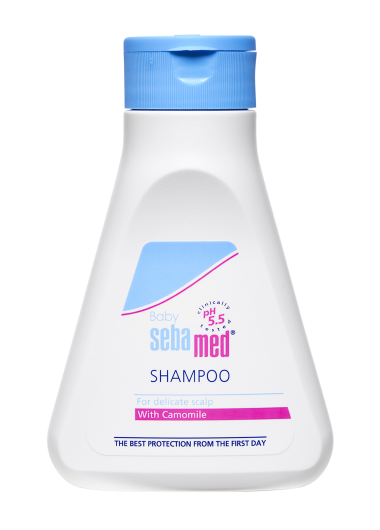Understanding Baby Cradle Cap: Causes, Symptoms, and Treatment Options
by Sebamed | Jun 16, 2023

Simplified with Sebamed
Cradle Cap, or Seborrheic Dermatitis is a common skin condition that affects infants. This is a harmless and temporary skin condition, which goes away on its own. However, it will become a common concern for most new parents out there. That's why you need to be aware of the causes, symptoms, and treatment options available for Cradle Cap.
Index [hide]
- What is Cradle Cap
- Cradle Cap symptoms
- Cradle Cap causes
- What does Cradle Cap look like
- Cradle Cap treatments
- How to get rid of Cradle Cap
- Conclusion
- Product Mentioned in the Blog
What is Cradle Cap?

Cradle cap can be scary but it can be dealt with!
Cradle Cap is a skin health condition that causes scaly, crusty patches on a baby's scalp. It is not contagious and does not cause discomfort to the baby, but it can cause itching and irritation in some cases. The condition is common and affects up to 70% of infants during their first few months of life.
Cradle Cap Symptoms
The most common symptom of this skin condition is the appearance of scaly, crusty patches on the scalp, although it can also occur on the eyebrows, eyelids, and behind the ears. The patches can vary in color from yellow to brown and may be accompanied by redness or inflammation. Some babies with Cradle Cap may also experience itching or have oily skin.
Cradle Cap Causes
What causes Cradle Cap? The exact cause of Cradle Cap is unknown, although several factors may contribute to its development. One potential cause is an overproduction of sebum, a natural oil produced by the sebaceous glands in the skin. This overproduction can cause a buildup of oil and dead skin cells, leading to the formation of scales and crusts. You can wipe these from the skin of your baby using a soft brush.
Another potential cause of Cradle Cap is a fungal infection caused by the yeast Malassezia. This fungus is commonly found on the skin and scalp and can cause inflammation and irritation, leading to the development of these yellow scales.
What does Cradle Cap look like?
Cradle Cap can appear as scaly, crusty patches on the scalp that may be yellow, brown, or white. The patches can be thick and greasy, and in some cases, may have a foul odor. The affected area may also be red and inflamed, and the patches can sometimes spread beyond the scalp to other areas of the body, such as the face, neck, and diaper area. Cradle Cap typically lasts a few weeks to several months, but it can resolve on its own without treatment. In some cases, the scaly patches may persist for longer or reoccur in the future. If you want to help your little one get rid of Cradle Cap fast, you will need to take a look at the treatment options mentioned below.
Cradle Cap Treatments

Brushing away cradle cap in a jiffy!
There are several Cradle Cap treatment options available to consider. Although it is important to note that it is a harmless and self-limiting condition that does not require treatment in most cases. Treatment is typically only recommended if the Cradle Cap is causing discomfort to the baby or if the patches are spreading beyond the scalp.
1. Olive oil
Massage olive oil onto the baby's scalp and let it sit for a few minutes before rinsing it off with a mild shampoo. This is one of the most popular Cradle Cap treatment options to try.
2. Petroleum jelly
Apply a small amount of petroleum jelly to the affected area to help loosen the scales and crusts.
3. Sebamed Shampoo
Sebamed Shampoo is delicate on the skin of your baby. It can help to protect natural moisture balance and prevent Cradle Cap.
4. Aloe vera
Apply aloe vera gel to the affected area to help reduce inflammation and irritation.
How to get rid of Cradle Cap?

A closer look at cradle cap.
Do you wonder how to get rid of Cradle Cap? The most effective way to get rid of Cradle Cap is to regularly wash the baby's scalp with a mild baby shampoo and gently brush the affected area with a soft-bristled brush. This can help loosen the scales and crusts, making them easier to remove. It is important to avoid using harsh shampoos or scrubbing the scalp too vigorously, as this can cause further irritation.
For more severe cases of Cradle Cap, a pediatrician may recommend a medicated Cradle Cap Shampoo such as the Sebamed Baby Shampoo to help control the inflammation and reduce the production of oil. In some cases, prescription medication may be necessary to treat a fungal infection.

Conclusion
Cradle Cap is a common and harmless skin condition that affects many infants during their first few months of life. While the exact cause of Cradle Cap is unknown, several factors, including an overproduction of sebum and fungal infections, may contribute to its development. When you see the signs of Cradle Cap in your little one, buy a Cradle Cap Shampoo such as the Sebamed Baby Shampoo, and you can help your little one to get rid of it.






